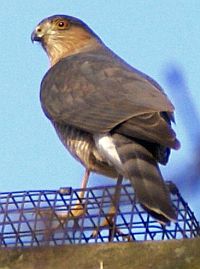 It seems like all I write about are birds of prey, but they’re the big, splashy birds of winter. Most of the songbirds have left town so at my house we’re down to starlings, house sparrows, mourning doves, crows, pigeons and a variety of hawks.
It seems like all I write about are birds of prey, but they’re the big, splashy birds of winter. Most of the songbirds have left town so at my house we’re down to starlings, house sparrows, mourning doves, crows, pigeons and a variety of hawks.
Yesterday as I walked to work I saw two coopers hawks fly over, one right after the other. They’re searching for food and hanging out at backyard feeders, as seen in this photo by Bill Parker.
Coopers hawks aren’t at the feeders for the seeds. They eat birds for a living, so they’re trying to catch an unsuspecting seed-eater. Entire flocks fall silent when this hawk is near. Starlings warn each other by making a high-pitched spitting sound. Everyone ducks for cover.
Coopers hawks are known to be jumpy and high strung. Unlike red-tailed hawks, they are always on the move – and they move fast. They can fly quickly through a forest and accurately catch prey with their talons.
At my grocery store’s parking lot I once saw a coopers hawk cut a single pigeon out of the flock and grab it from behind in mid-air. It was awe inspiring and it made me very glad I’m not something a coopers hawk wants to eat.
Both Cooper’s and Sharpies give a new meaning to the term “Bird Feeder.”
Vern
My comment is not directly related to “A Two Coopers Day”, but I was wondering if you might write a post about flocking. Why do birds flock? What kind of birds would you find flocking in our area? Why do different birds flock together? I thought of this because I saw what I thought was a Coopers Hawk chasing down a small flock yesterday on a golf course in Washington County. I find flocking birds fascinating and mesmerizing, and I would love to know more about it. I love ‘Outside My Window’ and read it every day. Thanks.
Sincerely,
Matt Zeitler